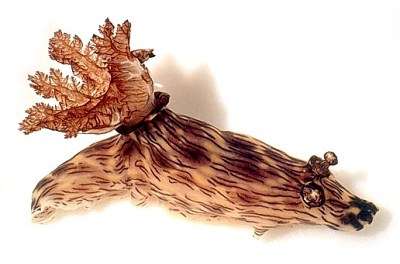
Jorunna rubescens
Bergh, 1876
Order: NUDIBRANCHIA
Suborder: DORIDINA
Superfamily: EUDORIDOIDEA
Family: Dorididae
DISTRIBUTION
Indo-West Pacific.
PHOTO
Mjimwema, approx. 20km S of Dar es Salaam, Tanzania, September 1973 in Syringodium & Cymodocea beds, shallow sublittoral. Lower left photo showing raised collar on rhinophore pocket; Lower right photo showing egg ribbon. PHOTOS: Bill Rudman.
Formerly known as Kentrodoris rubescens. See message
Growing up to 20cm in length, this polycerid-like dorid is considered to be a species of Jorunna. Its mantle is covered in small spiculate papillae (caryophyllidia) which are characteristic of that genus.
Reference:
• Bergh, L.S.R. (1876). Malacologische Untersuchengen. In: C.G. Semper, Reisen im Archipel der Philippinen, Wissenschaftliche Resultate, 10: 377-427
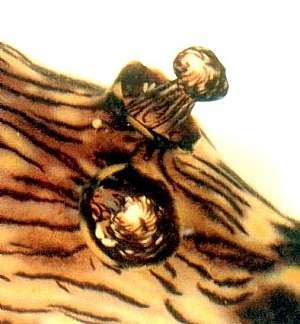
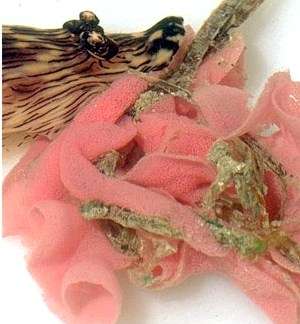
Rudman, W.B., 2000 (February 19) Jorunna rubescens Bergh, 1876. [In] Sea Slug Forum. Australian Museum, Sydney. Available from http://www.seaslugforum.net/find/kentrube
Related messages
Giant nudies mating - Thailand
May 13, 2010
From: Ingrid Dolensky
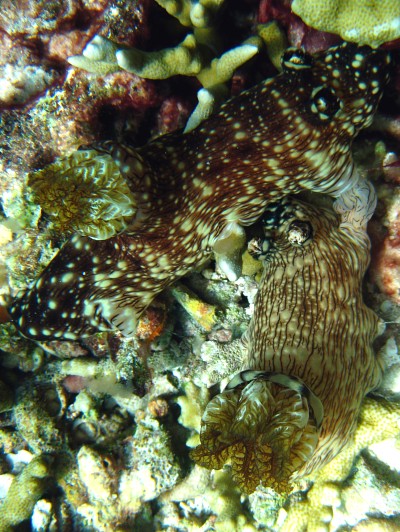
Hi,
Please find attached some photos of the "giant nudies" of Koh Haa Lagoon mating. They are the size of a ladies forearm (25-35cm).
We think they are Jorunna rubescens, and they seem similar to the photos of these that you have so far, though none of them seem as fond of branching coral as these.
A local dive instructor friend of ours first noticed these last year amongst the fire coral beds of Koh Haa lagoon in March/April 2009. As this is a very popular dive site we were all suprised that we had not noticed them before, as many of my divemaster and instructor friends have been diving there for years.
There were many of them on 2009, with many pink egg ribbons giving away their camouflage (10 or more nudies found in 10 minutes). They were all sitting on the top of the fire coral at this time (the ones we could see).
When I returned later in the year, I could not find them from October 2009-January 2010. Returning to dive in the lagoon in Feb/March 2010 they had returned. These were the only two I found on the dive where I had my camera.
My instructor friends that stay all year advise me they only see them at this time of the year for a few weeks. We think maybe they are underneath the fire coral or somewhere else the rest of the year, as they only appear when their eggs are around (although their camouflage is very good against the coral here).
Their rhinospores are a soft pink-rose colour when out, which they are not in these photos (maybe because they are mating?).
Locality: Koh Haa Lagoon, 8m, Thailand, Andaman Sea, 25 February 2010, branching coral area of lagoon with sand underneath. Length: 30 cm. Photographer: I. Dolensky.
Ingrid Dolensky
redfish44@yahoo.co.uk
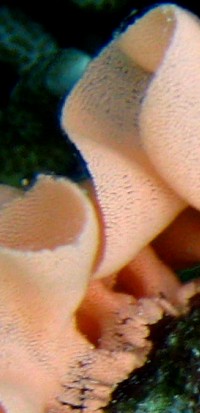


Dear Ingrid,
Yes these are Jorunna rubescens. Although this species grows to quite a large size I suspect it has an annual life cycle which means you are only likely to see it as it grows in size and perhaps like sea hares congregate to mate. Certainly in Tanzania I have seen it in huge congegrations in shallow reefal lagoons laying great numbers of their typical pink egg ribbons.
Best wishes,
Bill Rudman
Jorunna rubescens from Reunion Island
September 4, 2008
From: Hugues Flodrops
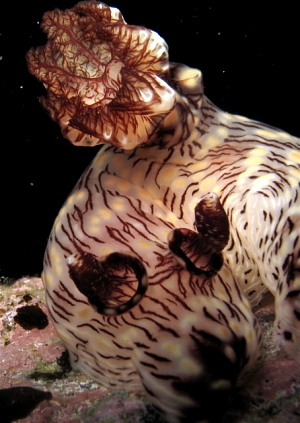
Concerning message #21704:
Dear Bill and Marcel,
We noticed at Etang-Salé, Reunion Island, two kinds of Jorunna rubescens. One with "Brown-shaped face" like message #21704 [upper photo] and the other [lower photos] with a "white face" and the mouth protuding under the mantle.
Locality: Etang-Salé, 1,5 metre, Reunion Island, Indian Ocean, 17 december 2006 and 30 january 2008. Length: 70 and 80 mm. Photographer: Hugues Flodrops.
Best regards.
Hugues.
hugues.flodrops@wanadoo.fr
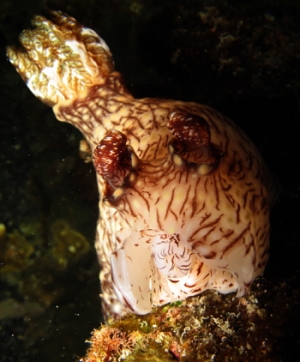
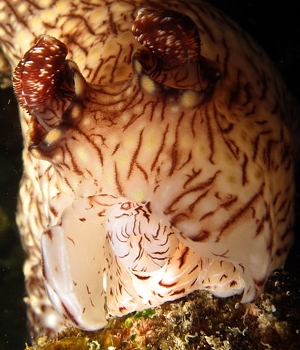
Thanks Hugues,
Best wishes,
Bill Rudman
Re: Jorunna rubescens from the Philippines
August 26, 2008
From: Marcel Tanke
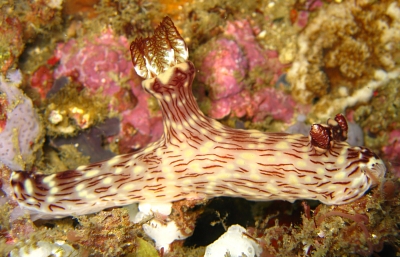
Concerning message #15253:
Dear Bill,
Last week we saw 2 Jorunna rubescens at the Anilao Twin Rock and Coala dives sites. The one in the first picture we saw during a nightdive. While looking at the pictures and also comparing with pictures on your site, I noticed that some J. rubescens have a "long, brown shaped face", while others have a "shorter, more round face in the color pattern of its body". As the 2 in the pictures attached.
Do you think this is a significent difference, or just one of the variation within the species? Later we also found eggs in that area, that I believe are from J. rubescens.
Locality: Anilao, Twin Rock and Coala sites, about 10-15 meters, Philippines, July 8 and 11, 2008, Sandy area within the reef. Length: 15 cm. Photographer: Marcel Tanke.
Best regards,
Marcel
marceltanke@cs.com
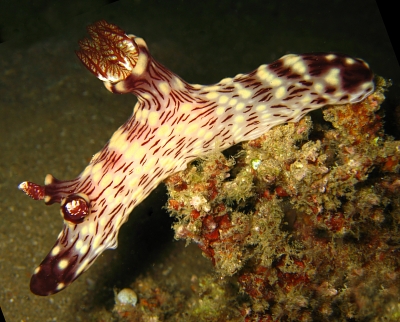
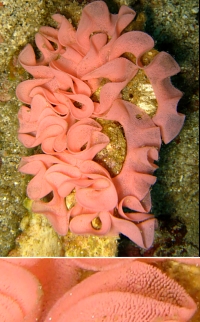
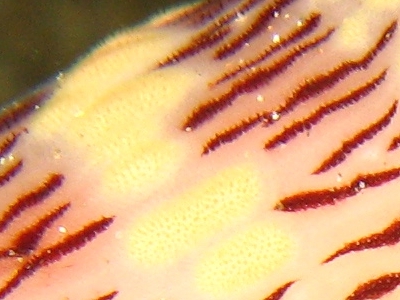
Dear Marcel,
I am sure the darker and lighter 'faces' are well within the normal variability of the species. I have included a couple of close-ups before to show the spiculate papillae [caryophyllidia] - which are one of the reasons that this nembrothid-like dorid is placed in the genus Jorunna - but the close-up alongside, from one of your photos, shows the caryophyllidia much better.
I agree that the egg ribbon is most probably that of Jorunna rubescens.
Best wishes,
Bill Rudman
Jorunna rubescens from Pemba Island
March 7, 2006
From: Wilhelm van Zyl
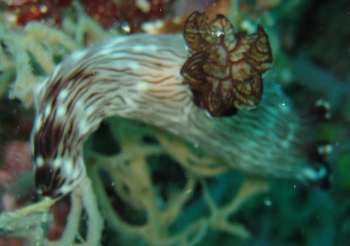
Hi Bill,
Another nudibranch from my trip to Zanzibar. This is one of the few species that I have not been able to identify, not even the family. I found it under a large overhang, which made it a bit diificalt to photograph properly.
Locality: Pemba island, Zanzibar, Tanzania. Indian Ocean. Depth: 15 m. Length: 10 cm. 14 October 2005. broken Coral reef. Photographer: Wilhelm van Zyl
Regards
Wilhelm
diving@cyberdale.co.za
Van Zyl, F.W., 2006 (Mar 7) Jorunna rubescens from Pemba Island. [Message in] Sea Slug Forum. Australian Museum, Sydney. Available from http://www.seaslugforum.net/find/15253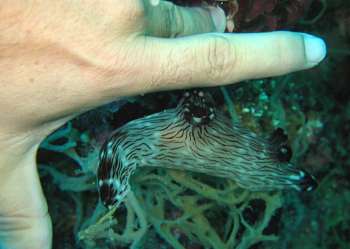
Dear Wilhelm,
Although it doesn't look much like a Jorunna, it is Jorunna rubescens. I am interested on the spaghetti like mass it is on. I thought at first it was Sea Hare egg mass but I think it might be a sponge. We don't know what this species eats, so this might be a clue to its food choice.
Best wishes,
Bill Rudman
Re: Jorunna rubescens from Bali
February 15, 2006
From: Roberto Sozzani
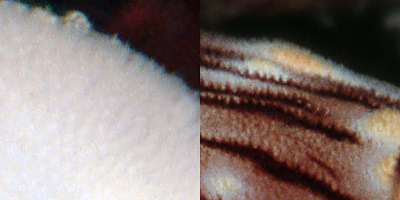
Concerning message #15706:
Dear Bill,
Some time ago I joined two photos to compare caryophyllidia of Jorunna funebris and Jorunna rubescens, both from Indonesia. Maybe this can be interesting for the Forum.
Best wishes
Roberto Sozzani
www.robertosozzani.it
roberto.sozzani@fastwebnet.it
Sozzani, R., 2006 (Feb 15) Re: Jorunna rubescens from Bali. [Message in] Sea Slug Forum. Australian Museum, Sydney. Available from http://www.seaslugforum.net/find/15784Thanks Roberto,
The skin of J. rubescens certainly appears to be quite smooth, like a Nembrotha, until you look at it very closely.
Bill Rudman
Jorunna rubescens from Bali
February 7, 2006
From: Marli Wakeling
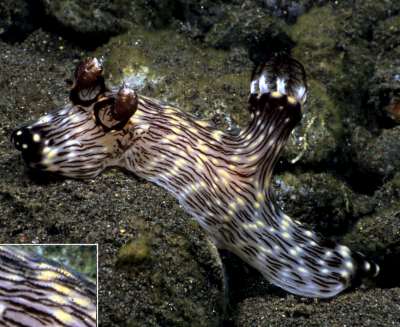
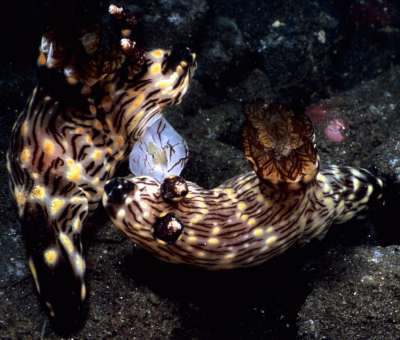
Hi Bill,
When we were at Tulamben this past summer, Jorunna rubescens was the most common nudibranch on our night dives. There were lots of them around, and there were these ones mating.
Locality: Tulamben "The River", Bali, Indonesia. Depth: 20 feet. Length: 10 cm. 25 July 2005. Sand bottom. Photographer: Marli Wakeling
Cheers,
Marli
scubamarli@gmail.com
Wakeling, M., 2006 (Feb 7) Jorunna rubescens from Bali. [Message in] Sea Slug Forum. Australian Museum, Sydney. Available from http://www.seaslugforum.net/find/15706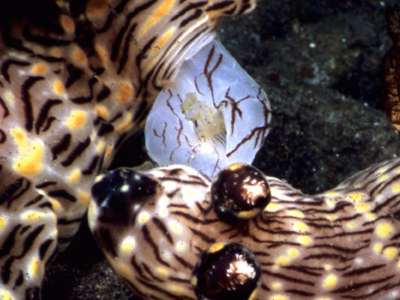
Thanks Marli,
This seems to be one of the opisthobranchs that sometimes appears in 'plague' proportions. Your upper photo rather nicely shows the spicules or caryophyllidia [see inset] on the skin. This is one of the reasons it is now considered to be a species of Jorunna. Your mating photo is also quite interesting because it shows part of the everted reproductive organs. Why this is interesting is because it is part of the reproductive system which we only see retracted in anatomical dissections. Because the anatomy of the reproductive organs is considered an important in comparing species and higher taxonomic work, new views of these organs are very valuable.
Best wishes,
Bill Rudman
Jorunna rubescens from the Maldives
May 29, 2005
From: Charles Rowe
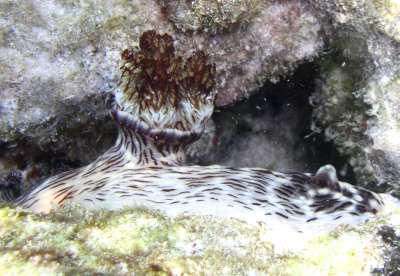
Hi Bill,
My partner and myself recently spent 10 days on Kuredu Island in the
Maldives. The attached animal was shot in one metre of water outside our
chalet using natural light. Not the best photo I admit but can you identify
it? It was taken on 18.April 2005.
Thanks.
Charles.
Charles.rowe@gmsa.com
Rowe, C., 2005 (May 29) Jorunna rubescens from the Maldives. [Message in] Sea Slug Forum. Australian Museum, Sydney. Available from http://www.seaslugforum.net/find/13866Dear Charles,
This strange animal is Jorunna rubescens. All its relatives are typically flat dorids, while this species looks like a badly shaped Nembrotha.
Best wishes,
Bill Rudman
Jorunna rubescens from Reunion island
February 22, 2005
From: Philibert Bidgrain

Dear Bill,
Reunion Island sea slugs.
Jorunna rubescens is relatively common in Reunion Island during the summer time, in "Etang sal les bains " lagoon where we can observe it laying its eggs. Two specimens have been observed, mating late December on the reef (15-20 m). This specimen was found by Philibert Bidgrain at "Etang sal les bains" lagoon, less than 1 m deep, size 220 mm, 01 January 2005
Best Regards
Philibert Bidgrain
http://vieoceane.free.fr/runseaslug/indexslug.htm
pbidgrain@yahoo.fr
Bidgrain, P., 2005 (Feb 22) Jorunna rubescens from Reunion island. [Message in] Sea Slug Forum. Australian Museum, Sydney. Available from http://www.seaslugforum.net/find/13007Thanks Philibert,
Bill Rudman
Jorunna rubescens from Anilao, The Philippines
February 17, 2005
From: Paul Osmond
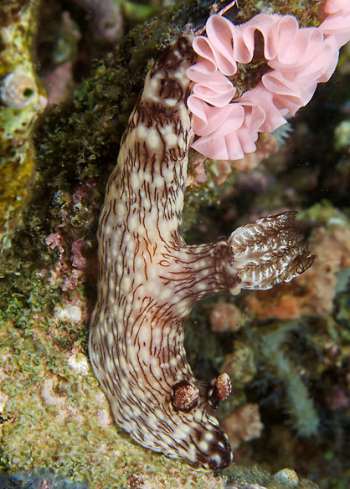
Hi Bill,
I had meant to send you these images right before the site went quiet, so I never got round to it.
This large speciman of Jorunna rubescens was busy laying an egg spiral on this coral head on a deeper reed in off of Anilao, The Philippines on one of the 'Sombrero Island' dive sites.
We came upon this individual basically towards the end of the laying and observed it for several minutes as it finshed and then moved off.
Locality: Anilao, Batangas, The Philippines. Depth: 25 m. Length: 15 cms. 15 March 2004. Coral Reef, White Sand Bottom. Photographer: Paul T. Osmond
After all the little species, this is a big nudibranch - this one in the 15cm range.
Enjoy,
Paul
marriard@deepseaimages.com
Osmond, P. T., 2005 (Feb 17) Jorunna rubescens from Anilao, The Philippines. [Message in] Sea Slug Forum. Australian Museum, Sydney. Available from http://www.seaslugforum.net/find/13158Dear Paul,
Thanks for the photo. This is certainly a strange looking animal and I must say I still find it difficult to think of it as a species of Jorunna. I am glad to see the egg ribbon you photographed is the same as ones I have seen the species laying in Tanzania. It's always good to get some confirmatory evidence.
Best wishes,
Bill Rudman
Kentrodoris rubescens with one rhinophore
February 3, 2003
From: Danny Van Belle
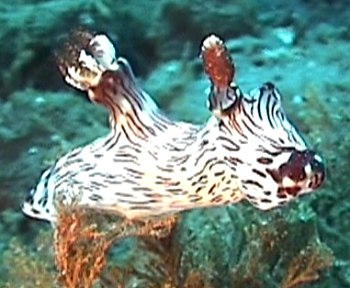
Hi Bill,
Here a Kentrodoris rubescens from Tulamben, Bali, filmed at 10m depth. Divesite: the river, 15 May 2000.
One rhinophore missing
Cheers,
Danny
dannyvb@hotmail.com
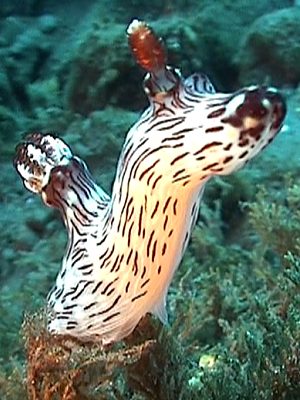

Thanks Danny,
Apart from the missng rhinophore these photos are a useful addition as they show the strange, almost polycerid, shape of this species very clearly. I can't say for certain, but considering that the left rhinophore pocket seems intact, I would think the rhinophore has been lost through misadventure [probably bitten off], rather than as a result of some developmental abnormality.
Best wishes,
Bill Rudman
Record of Kentrodoris rubescens
July 3, 2002
From: Fredy Brauchli
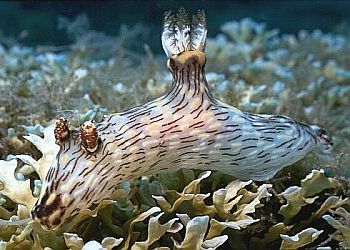
Hello Bill
Now that I am back from the Philippines, I can send you some interesting pictures. Here is Kentrodoris rubescens found at Pandan Island, Occ. Mindoro, Philippines.
Size: ca. 15 cm, depth: 20m, place: North Wall, date: March 25th 2002 .
Kind regards from Switzerland,
Fredy
http://www.subaqua.ch
brauchli@subaqua.ch
Brauchli, F., 2002 (Jul 3) Record of Kentrodoris rubescens. [Message in] Sea Slug Forum. Australian Museum, Sydney. Available from http://www.seaslugforum.net/find/7106Thanks Fredy,
Bill Rudman
Kentrodoris rubescens from Bali
February 21, 2002
From: Stuart Hutchison
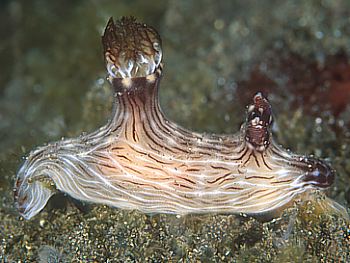
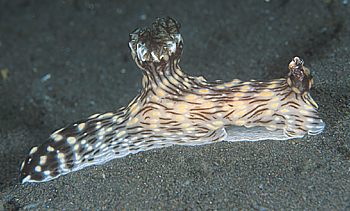
Bill,
Here's Kentrodoris rubescens from Bali, Indonesia on 15 Oct 2001. Depth 3m, lengths 35 and 120mm.
We found dozens of these guys, all in shallow water along the rocky shoreline, but only in areas where there was lots of algal growth.
Stuart.
stuart@stuarthutchison.com.au
Hutchison, S., 2002 (Feb 21) Kentrodoris rubescens from Bali. [Message in] Sea Slug Forum. Australian Museum, Sydney. Available from http://www.seaslugforum.net/find/6282Dear Stuart,
It is certainly interesting how they often occur in large numbers. The only times I found them in East Africa were in large numbers in shallow grass beds.
Best wishes,
Bill Rudman
Kentrodoris rubescens from Papua New Guinea
December 12, 2001
From: Mary Jane Adams
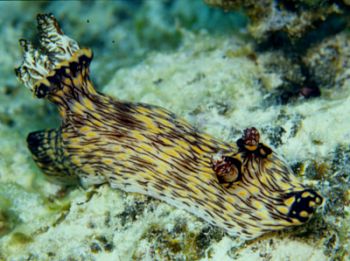

Hi Bill,
This is the first Kentrodoris rubescens I have ever seen in Papua
New Guinea. Is was crawling over the lagoon side of Horseshoe Reef, Bootless Bay at a depth of 5 meters. It seems appropriate that this weird looking beast showed up on Halloween.
Divesite: Wreck of the Pai II, Bootless Bay
Length: about 18-20 cm.
Oct. 31, 2001
Best regards,
Mary Jane
divepng@yahoo.com
Adams, M.J., 2001 (Dec 12) Kentrodoris rubescens from Papua New Guinea. [Message in] Sea Slug Forum. Australian Museum, Sydney. Available from http://www.seaslugforum.net/find/5810Dear Mary Jane,
From Tim Murrell's message it looks like K. rubescens has been in Bootless Bay for at least 6 months. Until your messages, I would have suggested, from my experience, that Kentrodoris rubescens was a spasmodic visitor rather than a permanent resident. I have only seen it alive a few times, the first time was in Tanzania, where I came across a very large population in a relatively shallow reefal lagoon with mixed sand, sea grass and coral heads. Most were large animals and there were many egg ribbons. In a month they had all gone. That is the only time I have seen more than two at a time.
Very interesting,
Best wishes,
Bill Rudman
Kentrodoris rubescens from Bootless Bay, PNG
December 11, 2001
From: Tim Murrell
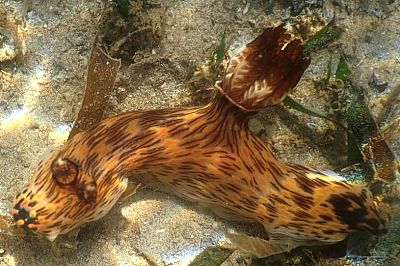
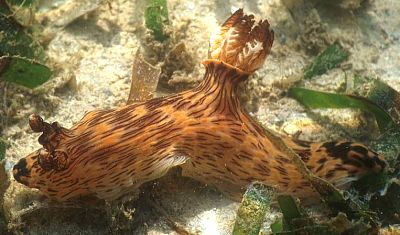
Dear Dr Rudman,
Recently, well OK 6 months ago. [June 2001] I visited Loloata Island in Bootless Bay,
Port Moresby, Papua New Guinea. These were taken in 1m of water at low tide in early June this year. There are two photos of the animal, and in a separate message one of the egg mass and one of two specimens mating.
Anyway are you able to ID these for me.
Thanks
Tim Murrell
maxx@bigpond.net.au
Murrell, T., 2001 (Dec 11) Kentrodoris rubescens from Bootless Bay, PNG. [Message in] Sea Slug Forum. Australian Museum, Sydney. Available from http://www.seaslugforum.net/find/5807Dear Tim,
Thanks for these and the mating photos. This is Kentrodoris rubescens. It is a strangely shaped dorid, closely related to Jorunna and other 'flat' dorids, although it looks like it should be related to animals like Nembrotha.
Best wishes,
Bill Rudman
Kentrodoris rubescens mating
December 11, 2001
From: Tim Murrell
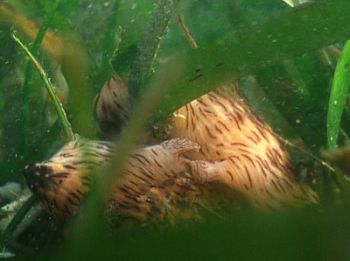
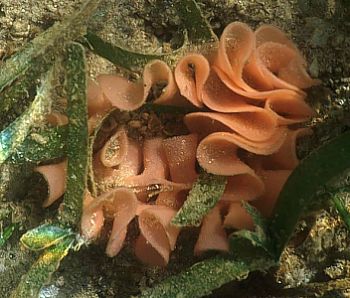
Dear Dr Rudman,
Here are some more photos of Kentrodoris rubescens to accompany by other message. They are also froom Loloata Island in Bootless Bay, Port Moresby, Papua New Guinea. These were taken in 1m of water at low tide in early June, 2001.
There is a photo of the egg mass and one of two specimens mating (sorry it isn't clearer, but do you know how hard it is to photograph two mating slugs in 1m of water with severe wind chop?)
Best wishes,
Tim Murrell
maxx@bigpond.net.au
Murrell, T., 2001 (Dec 11) Kentrodoris rubescens mating. [Message in] Sea Slug Forum. Australian Museum, Sydney. Available from http://www.seaslugforum.net/find/5808Thanks Tim,
The egg ribbons are an interesting comparison with mine from Tanzania. Yours are not quite so brightly coloured but are clearly the same shape and size.
Best wishes,
Bill Rudman
Kentrodoris rubescens from Philippines
February 20, 2000
From: Erwin Koehler
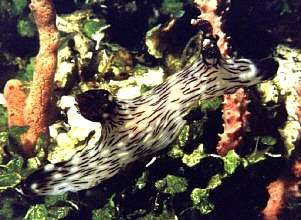
Bill,
Here is Kentrodoris rubescens (Bergh, 1876). I photographed it at "Sara's Place", Negros Is., Philippines, November 1998
Erwin
Medslugs.Koehler@t-online.de
Koehler, E., 2000 (Feb 20) Kentrodoris rubescens from Philippines. [Message in] Sea Slug Forum. Australian Museum, Sydney. Available from http://www.seaslugforum.net/find/1473Dear Erwin,
Sorry it's been a few weeks since you sent this.
Bill Rudman.
Kentrodoris rubescens from Vanuatu
February 20, 2000
From: Vinka Stenhouse

Dear Bill,
This one was found in 2 metres of water. Vanuatu. It was 16 cm long.
Yours sincerely,
Vinka Stenhouse.
Santo.
Vanuatu.
Dear Vinka,
This is Kentrodoris rubescens, a very strange looking dorid which looks more like a Nembrotha or Polycera than a species of Jorunna, to which it is considered to be most closely related.
Bill Rudman.
